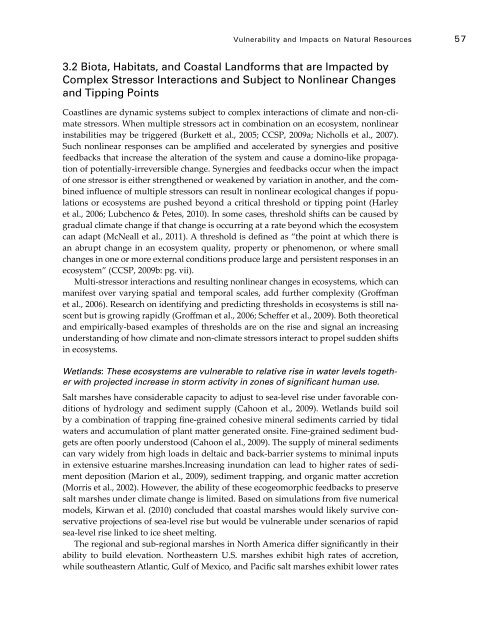Coastal Impacts, Adaptation, and Vulnerabilities - Climate ...
Coastal Impacts, Adaptation, and Vulnerabilities - Climate ...
Coastal Impacts, Adaptation, and Vulnerabilities - Climate ...
You also want an ePaper? Increase the reach of your titles
YUMPU automatically turns print PDFs into web optimized ePapers that Google loves.
Vulnerability <strong>and</strong> <strong>Impacts</strong> on Natural Resources 573.2 Biota, Habitats, <strong>and</strong> <strong>Coastal</strong> L<strong>and</strong>forms that are Impacted byComplex Stressor Interactions <strong>and</strong> Subject to Nonlinear Changes<strong>and</strong> Tipping PointsCoastlines are dynamic systems subject to complex interactions of climate <strong>and</strong> non-climatestressors. When multiple stressors act in combination on an ecosystem, nonlinearinstabilities may be triggered (Burkett et al., 2005; CCSP, 2009a; Nicholls et al., 2007).Such nonlinear responses can be amplified <strong>and</strong> accelerated by synergies <strong>and</strong> positivefeedbacks that increase the alteration of the system <strong>and</strong> cause a domino-like propagationof potentially-irreversible change. Synergies <strong>and</strong> feedbacks occur when the impactof one stressor is either strengthened or weakened by variation in another, <strong>and</strong> the combinedinfluence of multiple stressors can result in nonlinear ecological changes if populationsor ecosystems are pushed beyond a critical threshold or tipping point (Harleyet al., 2006; Lubchenco & Petes, 2010). In some cases, threshold shifts can be caused bygradual climate change if that change is occurring at a rate beyond which the ecosystemcan adapt (McNeall et al., 2011). A threshold is defined as “the point at which there isan abrupt change in an ecosystem quality, property or phenomenon, or where smallchanges in one or more external conditions produce large <strong>and</strong> persistent responses in anecosystem” (CCSP, 2009b: pg. vii).Multi-stressor interactions <strong>and</strong> resulting nonlinear changes in ecosystems, which canmanifest over varying spatial <strong>and</strong> temporal scales, add further complexity (Groffmanet al., 2006). Research on identifying <strong>and</strong> predicting thresholds in ecosystems is still nascentbut is growing rapidly (Groffman et al., 2006; Scheffer et al., 2009). Both theoretical<strong>and</strong> empirically-based examples of thresholds are on the rise <strong>and</strong> signal an increasingunderst<strong>and</strong>ing of how climate <strong>and</strong> non-climate stressors interact to propel sudden shiftsin ecosystems.Wetl<strong>and</strong>s: These ecosystems are vulnerable to relative rise in water levels togetherwith projected increase in storm activity in zones of significant human use.Salt marshes have considerable capacity to adjust to sea-level rise under favorable conditionsof hydrology <strong>and</strong> sediment supply (Cahoon et al., 2009). Wetl<strong>and</strong>s build soilby a combination of trapping fine-grained cohesive mineral sediments carried by tidalwaters <strong>and</strong> accumulation of plant matter generated onsite. Fine-grained sediment budgetsare often poorly understood (Cahoon el al., 2009). The supply of mineral sedimentscan vary widely from high loads in deltaic <strong>and</strong> back-barrier systems to minimal inputsin extensive estuarine marshes.Increasing inundation can lead to higher rates of sedimentdeposition (Marion et al., 2009), sediment trapping, <strong>and</strong> organic matter accretion(Morris et al., 2002). However, the ability of these ecogeomorphic feedbacks to preservesalt marshes under climate change is limited. Based on simulations from five numericalmodels, Kirwan et al. (2010) concluded that coastal marshes would likely survive conservativeprojections of sea-level rise but would be vulnerable under scenarios of rapidsea-level rise linked to ice sheet melting.The regional <strong>and</strong> sub-regional marshes in North America differ significantly in theirability to build elevation. Northeastern U.S. marshes exhibit high rates of accretion,while southeastern Atlantic, Gulf of Mexico, <strong>and</strong> Pacific salt marshes exhibit lower rates
















